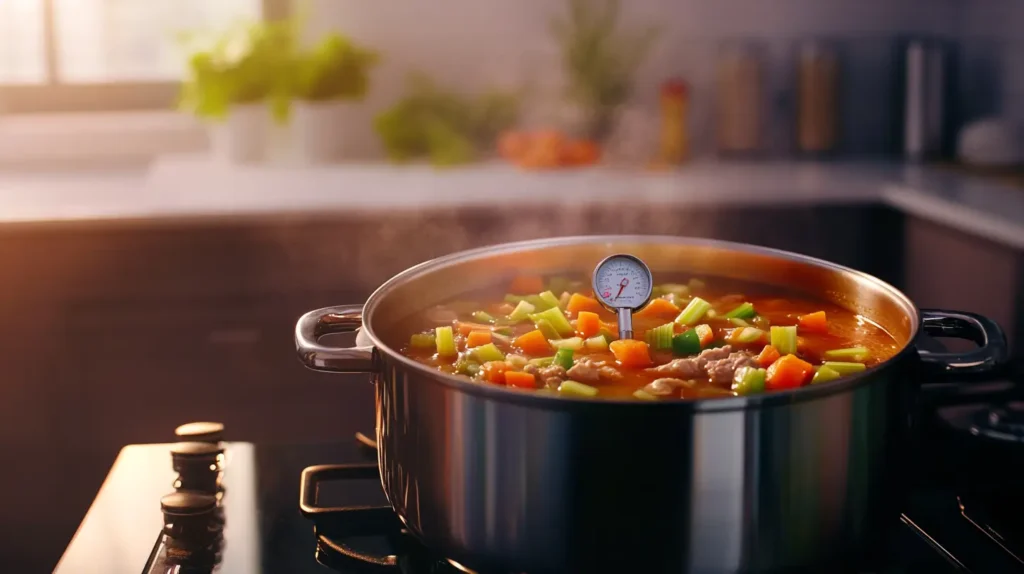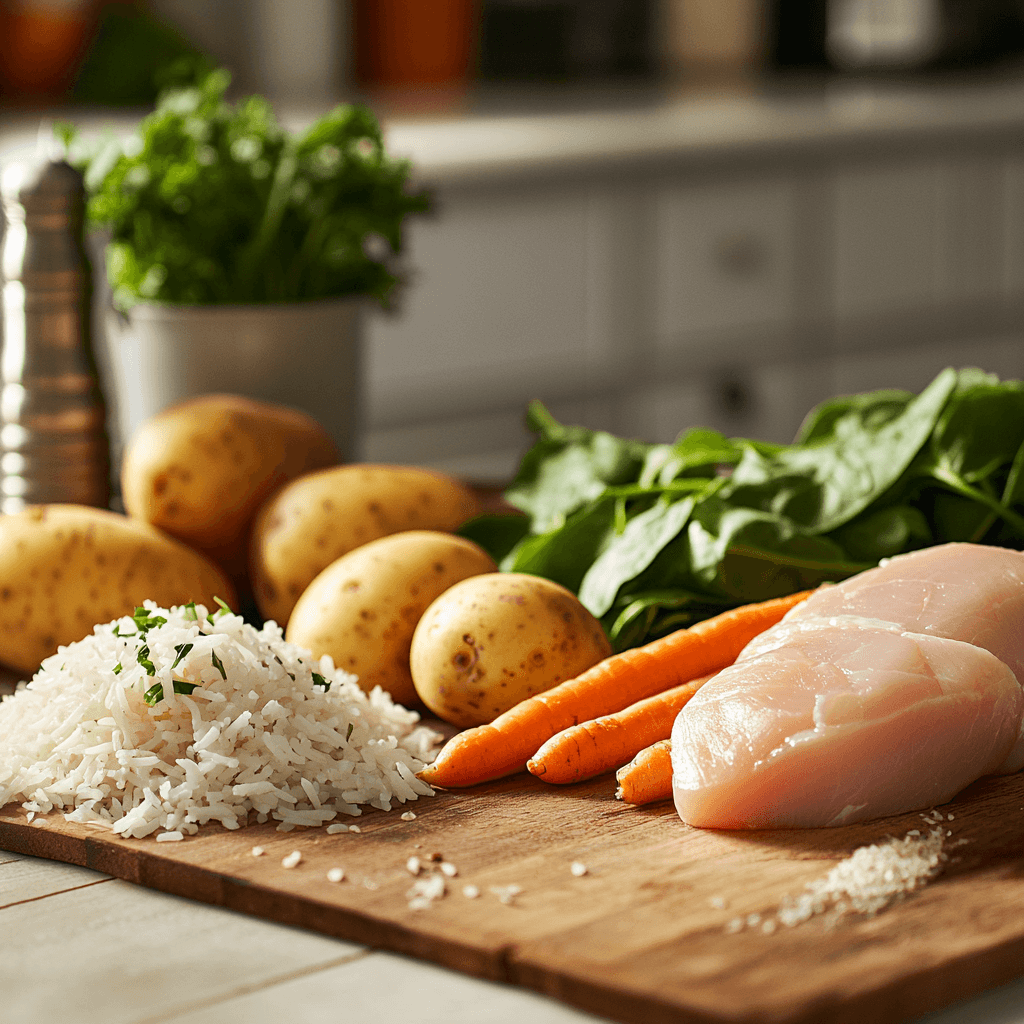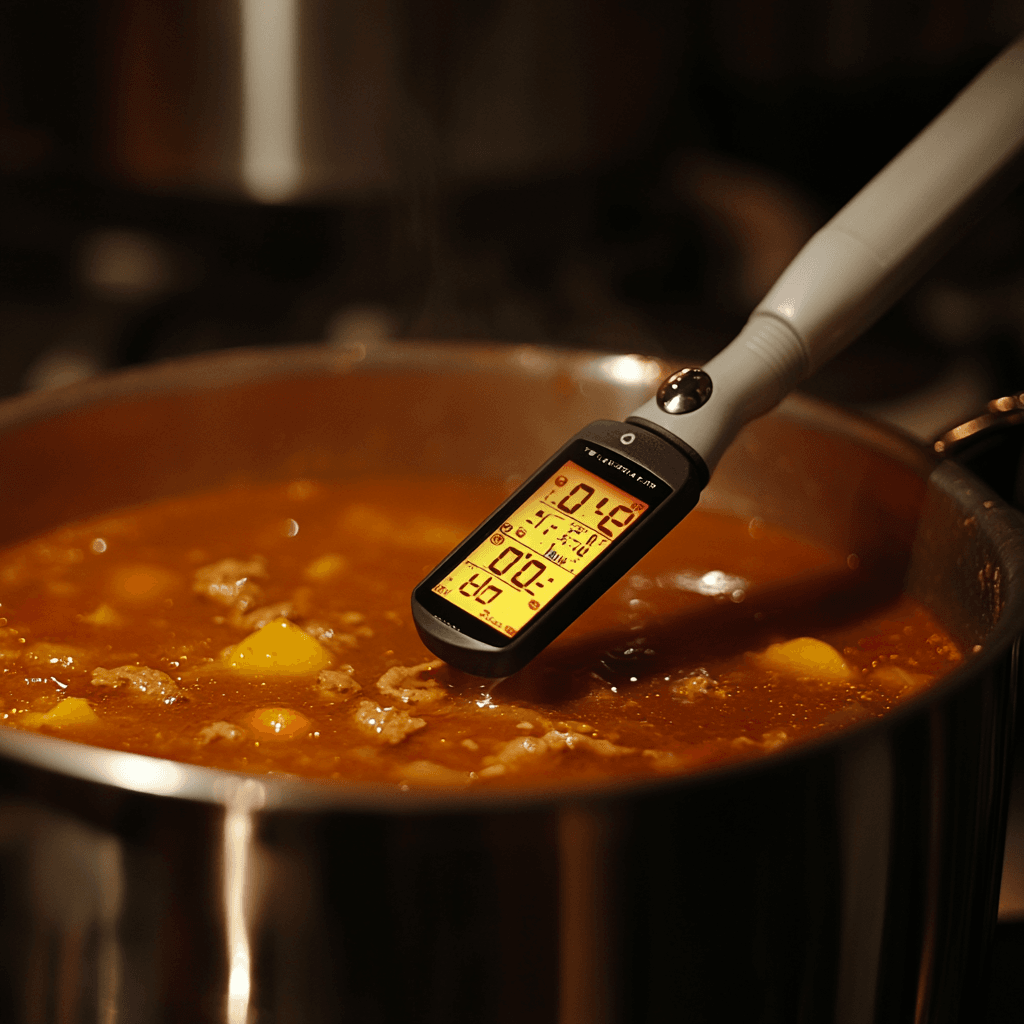Soup, a popular and versatile dish, is composed of various ingredients and liquids, creating an ideal medium for the growth of microorganisms, including bacteria. While soups are typically cooked, cooling and storage conditions can influence the proliferation of certain bacteria. Understanding the types of bacteria commonly found in soup, their sources, and potential health impacts is crucial for food safety and consumer well-being.

Table of Contents
Common Bacteria Found in Soup
1. Bacillus cereus
- Characteristics: Spore-forming bacterium.
- Sources: Often found in starchy ingredients like rice or pasta used in soup.
- Risks: Produces toxins that can lead to foodborne illness if soup is left at room temperature for too long.
- Prevention: Proper cooling and refrigeration below 40°F (4°C).
2. Escherichia coli (E. coli)
- Characteristics: Includes harmless strains and pathogenic variants like E. coli O157:H7.
- Sources: Contaminated vegetables, meat, or water used in soup preparation.
- Risks: Severe gastrointestinal distress and kidney complications in some cases.
- Prevention: Wash vegetables thoroughly and cook soup ingredients to an internal temperature of 165°F (74°C).
3. Salmonella spp.
- Characteristics: Non-spore forming, motile bacterium.
- Sources: Contaminated poultry, eggs, or raw vegetables.
- Risks: Causes salmonellosis, characterized by diarrhea, fever, and abdominal cramps.
- Prevention: Avoid cross-contamination and ensure thorough cooking.
4. Listeria monocytogenes
- Characteristics: Can survive and grow at refrigeration temperatures.
- Sources: Contaminated dairy or processed meats used in creamy soups.
- Risks: Listeriosis, particularly dangerous for pregnant women, newborns, and immunocompromised individuals.
- Prevention: Store soups at appropriate temperatures and consume them quickly.

Understanding Bacteria and Heat
What is Bacteria?
Bacteria are microscopic, single-celled organisms that exist almost everywhere on Earth, including in food and water. While many bacteria are harmless or even beneficial (e.g., those involved in digestion or fermentation), others can cause food spoilage and foodborne illnesses.
- Structure: Bacteria have a simple structure without a nucleus. They can be classified based on their shape, such as rods (bacilli), spheres (cocci), or spirals (spirilla).
- Reproduction: Most bacteria reproduce through binary fission, a rapid division process allowing their numbers to multiply quickly under favorable conditions.
- Types:
- Beneficial bacteria: Found in probiotics or used in food production (e.g., Lactobacillus in yogurt).
- Pathogenic bacteria: Harmful and capable of causing diseases (e.g., Salmonella, E. coli).
How Bacteria Contaminate Food
Bacteria can enter and contaminate food through various pathways, including:
- Raw Ingredients:
- Raw meat, poultry, seafood, and unwashed vegetables often carry bacteria from their natural environment or during processing.
- Cross-Contamination:
- Bacteria can transfer from one surface or food item to another through utensils, cutting boards, or hands.
- Improper Storage:
- Foods stored at incorrect temperatures encourage bacterial growth, particularly within the “danger zone” of 40°F to 140°F (4°C to 60°C).
- Human Handling:
- Bacteria from skin, nasal passages, or unsanitary practices can contaminate food during preparation.
- Environmental Factors:
- Airborne bacteria, contaminated water, or unclean kitchen equipment can introduce harmful microorganisms into food.
The Impact of Heat on Bacteria
Heat is one of the most effective methods to kill bacteria and ensure food safety. Its impact on bacteria depends on the temperature, exposure time, and type of bacteria:
- Heat Sensitivity of Bacteria:
- Most bacteria, including pathogens, are killed when exposed to temperatures above 165°F (74°C).
- Spore-forming bacteria like Clostridium botulinum and Bacillus cereus may survive cooking but can be inactivated by sustained higher temperatures or pressure cooking.
- Stages of Heat Application:
- Pasteurization: Heating food to moderate temperatures (e.g., 140°F-160°F or 60°C-72°C) for a specific time to kill harmful bacteria while preserving food quality.
- Boiling: Bringing food to 212°F (100°C) at sea level is sufficient to destroy most bacteria and pathogens.
- Sterilization: High temperatures (above 250°F or 121°C) combined with pressure, as in canning, eliminate all bacteria and spores.
- Thermal Death Time:
- The time required to kill a specific bacterial population at a given temperature.
- For example, Salmonella is inactivated at 165°F (74°C) within a few seconds, but spores of Clostridium require prolonged exposure to higher temperatures.
- Limitations of Heat:
- Heat-resistant toxins produced by some bacteria, such as Staphylococcus aureus and Bacillus cereus, may remain active even after cooking.
- Uneven heating, as in microwaves, can leave pockets where bacteria survive.

The Science of Boiling
What Does Boiling Involve?
Boiling is a fundamental cooking method that involves heating a liquid, typically water, to its boiling point (212°F or 100°C at sea level). At this temperature, water molecules rapidly vaporize into steam, creating bubbles that rise to the surface.
- Physical Process:
- Heating water increases the kinetic energy of its molecules until it transitions from a liquid to a gas.
- Boiling is influenced by atmospheric pressure, which affects the boiling point. For instance, at higher altitudes, water boils at lower temperatures.
- Application in Cooking:
- Boiling is used to cook, sterilize, and prepare foods, ensuring ingredients are softened, blended, or free of harmful microorganisms.
- In food safety, boiling is particularly important for soups, stews, and broths, where ingredients are cooked together in liquid.
Temperatures and Bacterial Death
Bacteria are sensitive to heat, and boiling water is a reliable method to eliminate most pathogens. The relationship between temperature and bacterial death involves several key factors:
- Threshold Temperatures:
- Most pathogenic bacteria are killed at temperatures above 165°F (74°C).
- Boiling (212°F or 100°C) effectively destroys the majority of bacteria, viruses, and parasites.
- Heat-Resistant Bacteria:
- Some bacteria, like Clostridium botulinum and Bacillus cereus, form spores that can survive boiling. However, these spores require prolonged exposure to higher temperatures (e.g., pressure cooking at 250°F or 121°C).
- Inactivation of Toxins:
- While heat kills bacteria, it may not neutralize heat-stable toxins produced by some species (e.g., Staphylococcus aureus). Preventing bacterial growth before boiling is essential to minimize toxin formation.
Can Boiling Soup Eliminate Bacteria?
Types of Bacteria Commonly Found in Soup
Broth, due to its diverse ingredients and nutrient-rich environment, can harbor various bacteria, particularly if not handled, stored, or cooked properly. Common bacteria include:
- Bacillus cereus:
- Found in starchy ingredients like rice or potatoes.
- Produces heat-resistant spores that can survive boiling.
- Clostridium perfringens:
- Thrives in improperly cooled or reheated soup.
- Spores can withstand boiling temperatures but require prolonged heat to deactivate.
- Escherichia coli (E. coli):
- Contaminates soup through raw vegetables, meat, or water.
- Most strains are killed at 165°F (74°C), making boiling effective against them.
- Salmonella spp.:
- Commonly present in poultry, eggs, or raw vegetables used in soup.
- Boiling eliminates it effectively if maintained long enough.
- Listeria monocytogenes:
- Found in dairy products or processed meats.
- Can be killed at boiling temperatures but survives in improperly heated sections.
Studies and Research on Boiling and Bacteria
- Effectiveness of Boiling:
- Research has shown that boiling kills most non-spore-forming bacteria within minutes. A study published in the Journal of Food Protection found that boiling water was 99.99% effective in inactivating common foodborne pathogens.
- Spore-Forming Bacteria:
- Studies indicate that spores of Bacillus cereus and Clostridium perfringens remain viable after boiling, requiring alternative measures like pressure cooking for complete sterilization.
- Toxin Heat Resistance:
- A study in the Food Microbiology Journal highlighted the resilience of bacterial toxins, particularly those from Staphylococcus aureus, which remain active even after prolonged boiling.
- High-Altitude Adaptations:
- Research from the American Journal of Public Health emphasizes the need for longer boiling times at high altitudes to compensate for the lower boiling point of water.
Safety Tips for Cooking Soup
Best Practices for Preparing Broth
- Start with Fresh Ingredients:
- Use fresh, high-quality ingredients to reduce the risk of contamination.
- Wash vegetables thoroughly under running water and store perishable items in the refrigerator until use.
- Cleanliness During Preparation:
- Wash hands with soap and water before handling food.
- Sanitize cutting boards, knives, and utensils to prevent cross-contamination.
- Use separate boards for raw meat and vegetables.
- Safe Thawing of Ingredients:
- Thaw frozen meat or poultry in the refrigerator, not at room temperature.
- Avoid adding partially thawed or frozen items directly to the soup, as this may prevent even cooking.
- Maintain Proper Cooking Temperatures:
- Use a food thermometer to ensure meat and poultry are cooked to an internal temperature of 165°F (74°C).
When to Boil and for How Long
- Boiling During Cooking:
- Bring the Broth to a rolling boil to ensure all ingredients reach a safe temperature.
- Allow the Broth to boil for at least 1-3 minutes before reducing the heat to simmer.
- Simmering for Thorough Cooking:
- After boiling, simmer the Broth for an extended period to allow even heating and thorough cooking of all components.
- Reheating Leftover Soup:
- Reheat leftovers to a rolling boil (at least 165°F or 74°C) and maintain the temperature for 1-2 minutes to eliminate any bacteria that may have grown during storage.
- Altitude Adjustments:
- At higher altitudes, where water boils at lower temperatures, extend boiling times to compensate for reduced heat intensity.
Additional Safety Measures Beyond Boiling
- Rapid Cooling and Storage:
- Cool leftover Broth quickly by dividing it into smaller portions and placing it in shallow containers.
- Refrigerate within 2 hours of cooking to prevent bacterial growth.
- Proper Storage:
- Store soup in airtight containers and keep it refrigerated at or below 40°F (4°C).
- Consume refrigerated soup within 3-4 days or freeze for longer storage.
- Avoiding the “Danger Zone”:
- Bacteria multiply rapidly between 40°F (4°C) and 140°F (60°C). Avoid leaving soup in this temperature range for more than 2 hours.
- Reheating and Serving:
- Stir soup while reheating to ensure even temperature distribution.
- Discard soup that has been left out at room temperature for more than 2 hours or reheated more than once.
- Toxin Awareness:
- Remember that some bacterial toxins, like those from Staphylococcus aureus or Bacillus cereus, are heat-resistant. Prevent their formation by adhering to proper cooling and storage practices.
Alternatives to Boiling for Ensuring Safety
Other Cooking Methods and Bacterial Reduction
While boiling is effective, other cooking methods can also ensure the safety of soup by eliminating bacteria and pathogens:
- Pressure Cooking:
- Utilizes high heat and pressure (above 250°F or 121°C) to destroy bacteria and heat-resistant spores, such as those from Clostridium botulinum.
- Ideal for dense or starchy soups that might harbor spore-forming bacteria.
- Slow Cooking:
- If properly managed, slow cookers can maintain temperatures above 165°F (74°C) to kill most bacteria.
- However, ensure that the cooker reaches a safe temperature quickly and ingredients aren’t left in the “danger zone” for extended periods.
- Steaming:
- Effective for pre-cooking individual ingredients like vegetables or seafood before adding them to the soup.
- Kills surface bacteria without submerging food in liquid.
- Sous Vide:
- Cooking soup components in vacuum-sealed bags submerged in water baths at controlled temperatures.
- Requires precision to ensure food reaches a pasteurization-safe temperature for a sufficient duration.

The Role of Preservatives
Preservatives can help extend the shelf life of soups by inhibiting bacterial growth, particularly in commercially produced or stored soups. While not a substitute for proper cooking, they can provide an additional layer of safety:
- Natural Preservatives:
- Salt: High concentrations of salt can reduce water activity, inhibiting bacterial growth.
- Acidity: Ingredients like vinegar or lemon juice lower the pH, making the environment less favorable for bacteria.
- Spices: Some spices, like garlic, cinnamon, and cloves, possess antimicrobial properties.
- Artificial Preservatives:
- Sodium benzoate or potassium sorbate are commonly added to soups to prevent spoilage.
- Usage must comply with food safety regulations and consumer preferences.
- Vacuum Sealing and Canning:
- Preservative-free soups can be stored safely by vacuum sealing or canning, both of which remove oxygen and create sterile conditions.
Importance of Soup Storage and Handling
Proper storage and handling are critical alternatives to boiling for maintaining soup safety, particularly for leftovers or commercially produced soups:
- Refrigeration:
- Store soup at or below 40°F (4°C) to slow bacterial growth.
- Use airtight containers to reduce exposure to contaminants.
- Freezing:
- Freezing soup halts bacterial activity entirely.
- Use freezer-safe containers, and label them with the storage date. Consume within 2-3 months for optimal quality.
- Handling Practices:
- Avoid dipping utensils repeatedly into stored soup to prevent contamination.
- Always reheat to at least 165°F (74°C) before consuming, even if the soup has been refrigerated.
- Vacuum Packing and Sterilization:
- Commercial techniques like vacuum packing and sterilization ensure soups are safe for extended storage without refrigeration.
- These methods effectively reduce oxygen and kill bacteria.
FAQs on Boiling Soup and Bacteria
1. Does boiling soup kill all bacteria?
- Answer: Boiling kills most bacteria and pathogens, including Salmonella and E. coli. However, it does not destroy heat-resistant spores, such as those from Clostridium botulinum and Bacillus cereus. These require higher temperatures, achieved with pressure cooking, for complete inactivation.
2. How long should I boil soup to make it safe?
- Answer: Boil soup for at least 1-3 minutes to ensure most bacteria are killed. If reheating, ensure it reaches a temperature of at least 165°F (74°C) throughout. Stir the soup to distribute heat evenly, especially for thick or chunky preparations.
3. Can I Use Milk Instead of Cream in Soup?
- Answer: Using milk as a substitute for cream in soup is a simple, cost-effective, and healthier alternative that still delivers a satisfying creamy texture. While milk lacks the high fat content of cream, it can successfully replicate its richness with the help of thickening agents, blending techniques, and complementary fat sources like butter or cheese.
4. Is boiling necessary if I refrigerate or freeze soup?
- Answer: Refrigeration and freezing slow bacterial growth but do not kill bacteria. Boiling is necessary before serving to eliminate any active bacteria and ensure the soup is safe to eat.
Conclusion
Boiling soup is an effective way to kill most harmful bacteria, including Salmonella, E. coli, and Listeria. However, heat-resistant spores from bacteria like Bacillus cereus and Clostridium botulinum may survive standard boiling temperatures. While boiling at 212°F (100°C) destroys most pathogens, some bacterial toxins remain active even after prolonged heating.
To ensure maximum food safety, it’s crucial to follow best practices beyond boiling, such as:
✔ Cooking soup to at least 165°F (74°C) before serving.
✔ Proper cooling and refrigeration below 40°F (4°C) within 2 hours.
✔ Avoiding the “danger zone” (40°F-140°F or 4°C-60°C) where bacteria multiply rapidly.
✔ Using pressure cooking (250°F / 121°C) for soups that may contain heat-resistant spores.
While boiling makes soup safer, proper storage, reheating, and hygiene play a crucial role in preventing bacterial growth and foodborne illnesses. By following these guidelines, you can enjoy a warm, delicious, and safe bowl of soup every time! 🍲🔥
